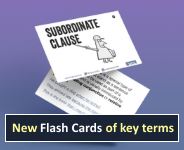Writing with tense and aspect
This lesson asks students to apply their understanding of tense, aspect, and time to structure passages of writing.
Goals
- Arrange sentences in order based on tense and aspect in the sentences.
- Practise ordering and re-ordering sentences in various ways using tense and aspect to convey the appropriate order of events.
Lesson Plan
The teacher explains that today, we will arrange a passage of writing and explore expressions of time in English.
On Slide 1 in the Activity 1 page in the right hand menu, you will see a set of sentences which tells a story. Students should do the following:
- Arrange the sentences in the order you think they happened. Do this by dragging the tiles around the screen or smart board. Match the order of sentences to the order of events in the story.
- Consider whether it is possible to change the order of the sentences a little and still tell a story that makes sense.
- Experiment with some reordering and see what works.
Students should discuss what they notice about the tense and aspect forms and how they affect the ordering.
Then, try the same ordering task with the set of sentences in Slide 2.
- First place the sentences in the order you think the events happened.
- Then see whether it is possible to reorder some of the sentences and still tell a story that makes sense.
- Think about how the different tense and aspect forms allow you to do this.
Finally, in Activity 2, students are given an outline sequence of events. Ask them to write a short story using this sequence of events; they are free to add further events to the sequence. They will need to use suitable tense and aspect forms to tell the story.
They are asked to write two versions of the story:
- In the first, tell all the events in the order that they happen.
- In the second, vary the order in which you tell the events, using suitable tense and aspect forms to do this. For example, you might start part-way through the sequence of events and refer back to the earlier ones.
Welcome!

Englicious is totally free for everyone to use!
But in exchange, we ask that you register for an account on our site.
If you’ve already registered, you can log in straight away.
Since this is your first visit today, you can see this page by clicking the button below.
- Printer-friendly version
- Log in to view or leave comments

